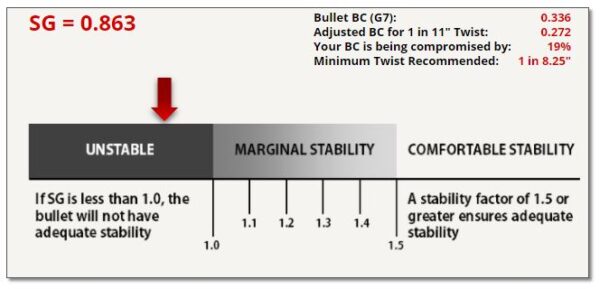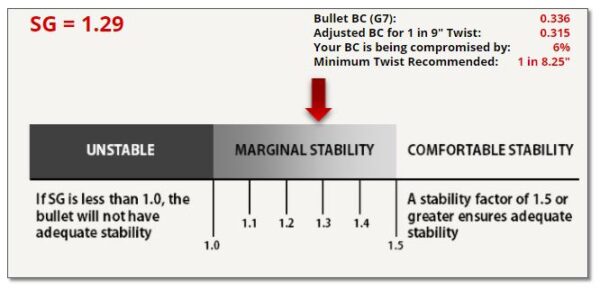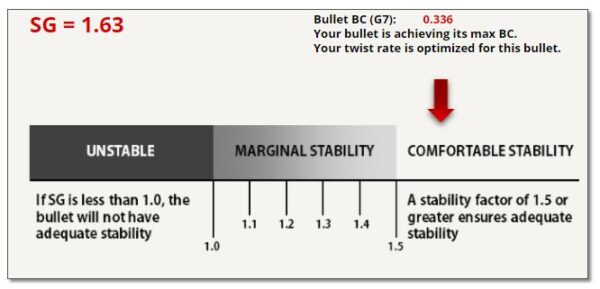If you’ve used our twist rate stability calculator and found the Specific Gravity (SG) of a given bullet being shot from your rifle under specific environmental conditions, you might be wondering why an SG of 1 is unstable, an SG of 1.5 is recommended, and why SG’s in between will not provide you with “optimal results on target.”
SG is the gyroscopic stability factor. It is the measure of gyroscopic stability applied to the bullet by spin. There are 3 ranges on the table below: unstable, marginal stability, and comfortable stability.

Unstable: SG is less than 1.0. Bullet is unstable. Other indicators are bullet “key holing” (bullet going sideways through target instead of point forward. And extreme inaccuracy of bullet at all ranges.

Marginal Stability: SG IS 1.0 TO 1.49. Note the box above the line graph: Your bullet is marginally stable. This does not mean that the bullet will be unstable in its flight, in fact you may be able to shoot good groups under these conditions. However, it does mean that the bullet Ballistic Coefficient (BC) will not be optimized. This information can be found on the top right area of the example above. It first shows the BC the bullet would have when stable, then what the adjusted BC would be for the given twist rate, the percentage that the bullet BC is compromised, and then the minimum twist rate we recommend for you to get optimal results with the given bullet, load, and environmental conditions.
At short ranges this effect on the BC will usually be too small to notice. At mid-ranges out to 600 yards you’ll begin to see the effects. At long range (600 yards plus) your groups will grow even more. That being said, in most cases a marginally stable bullet will not tumble and will be flying point forward to the end of its flight.
To see just how big the effect on BC can be in your case, visit the Berger Ballistics Calculator then fill in all the required parameters with your data. First, calculate your range card using the full BC of the bullet you are using. Then calculate your range card using the compromised BC value you got from the twist rate calculator. Now compare the drop at various distances. This gives you a rough idea of how much the reduction in BC will affect your shooting experience.

Comfortable Stability: An SG of 1.5 or greater ensures adequate stability and optimal bullet BC.
Here is why the 1.5 number is used: “Typically, it’s wise to aim for an SG of at least 1.5 when selecting a barrel twist for a particular bullet. Technically speaking, SG only has to be greater than 1.0, so why aim for the higher value? There are a couple of reasons. The more important reason is to have that extra .05 of SG as a safety margin. If you aim for an SG of 1.0 and conditions exist that cause it to drop to 0.99, you have a problem. The 0.5 safety margin in SG is there to account for non-standard atmospheric conditions, imperfectly balanced bullets, and errors in the prediction of the SG value itself”. – Bryan Litz, Applied Ballistics for Long Range Shooting Third Edition (pg 160).
Is an SG greater than 1.5 better? Is a faster than needed barrel twist rate better yet for stability and accuracy? Let me quote again from Bryans book “the bullet does not experience significantly more drag if it is flying with excessive stability” Does that mean that there is no downside to over spinning bullets ? Not exactly. The relationship between stability and precision is probably where the bulk of stability misconceptions exist. Gyroscopic stability can affect precision in two ways. First if the bullet is not adequately stabilized it will emerge from the muzzle and fly with some significant amount of yaw until it stabilizes. This situation is bad for precision and adds significantly to the bullets drag. This problem can be solved simply by insuring that the bullet is fired with sufficient stability by choosing a proper twist rate.
“It’s also possible for precision to be compromised if the bullet is spinning faster than it has to be for adequate stability. When a bullet emerges from the muzzle of a rifle, it’s spinning very fast. Any imperfection in the shape, balance, or alignment of the bullet will cause it to disperse away from the bore line when it exits the muzzle. The amount of dispersion is related to how severe the imperfections in the bullet are, and also how fast the bullet is spinning. Higher spin rate produce more dispersion. This situation can create the illusion that the bullet’s dispersion is caused by excessive stability, but that’s not the reality. The actual stability level of the bullet is not what causes the dispersion. The imperfections in the bullet cause dispersion, and the dispersion is increased the faster the bullet is spinning. The more balanced the bullet, the less dispersion will result from spinning them faster. One of the reasons why short range benchrest shooters choose to shoot short, blunt, flat base bullets is because they require such a slow twist rate to stabilize”. – Bryan Litz, Applied Ballistics for Long Range Shooting Third Edition (pgs. 167-68).
Let me add one more thing to this discussion. Excessive barrel twist rates by themselves or when combined with a long barrel (over 28 inches) and other factors can also cause bullet failures due to heat and friction. Especially when the bullet Rotations Per Minute (RPM) get close to or exceed 300,000 RPM. The formula to find what the bullet RPM is: Muzzle Velocity times 720 = X. X divided by your barrel twist rate = BULLET RPM.
This article has been a summarized version of bullet stability and only covers the gyroscopic part of this subject. There is also a dynamic part that extended range shooters (beyond 1,000 yards) should be familiar with. For more information on this subject, see Chapter 11 of the book, Applied Ballistics for Long Range Shooting Third Edition by Bryan Litz.
- What is the Berger Twist Rate Stability Calculator?
- How do you use a twist rate stability Calculator?
- Why would you use a twist rate calculator?
- How does the Berger twist rate calculator work?
- What is the Miller twist rate formula?
- Why is the Miller twist rule better than the Greenhill rifling formula?
- What does SG mean?
- What SG number is best?
- What SG do I want for my rifle/barrel?
- Why doesn’t the Miller twist rate formula work with flat based bullets?
- What SG do I need to stabilize a bullet?
- Why do I want an SG of 1.5 or higher?
- What does rifle twist rate mean?
- Why does barrel twist rate matter?
- What is my optimal barrel twist rate?
- What is the best barrel twist rate?
- Why is G7 BC better than G1 BC?
- What is the difference between G1 BC and G7 BC?